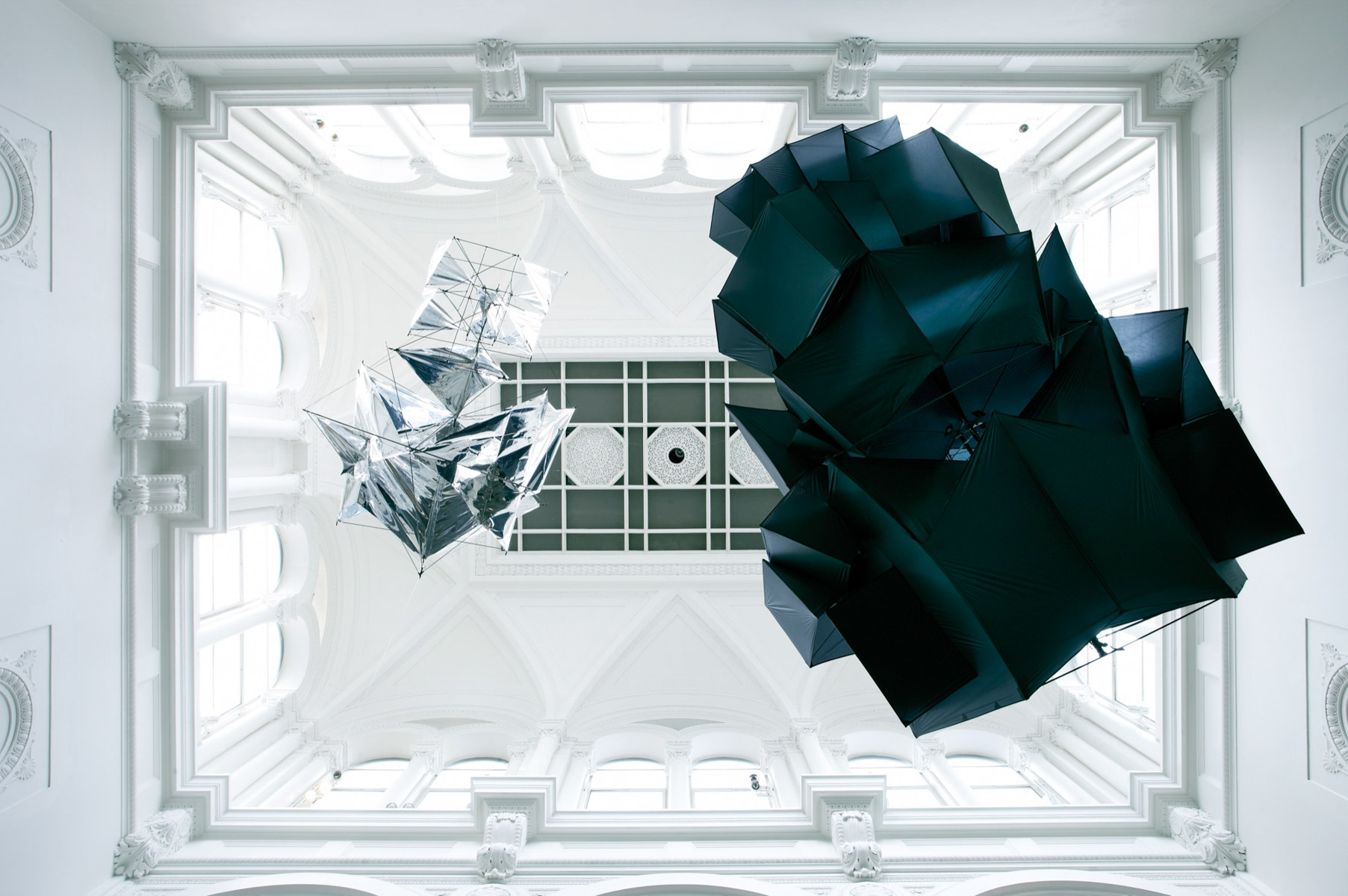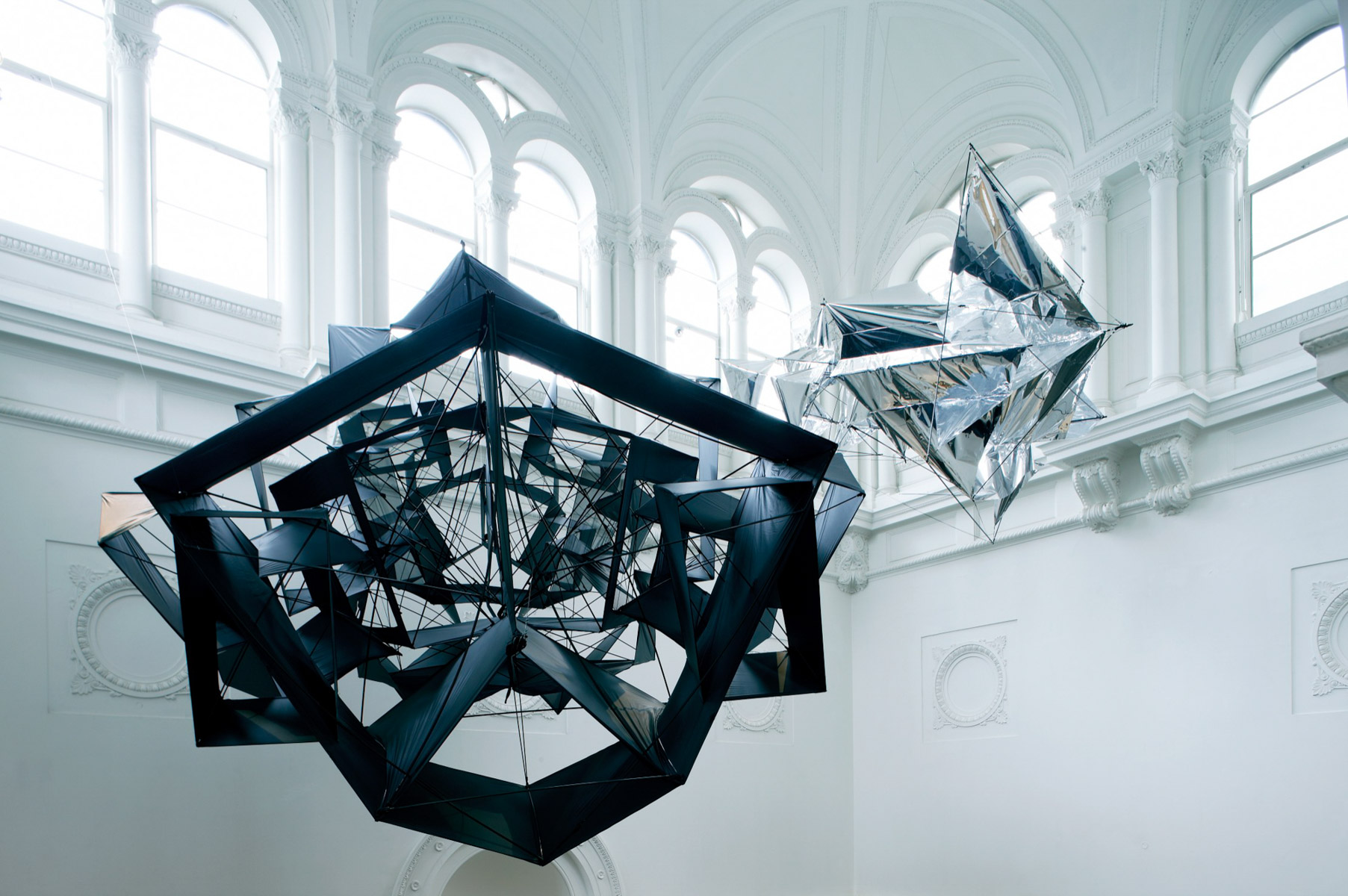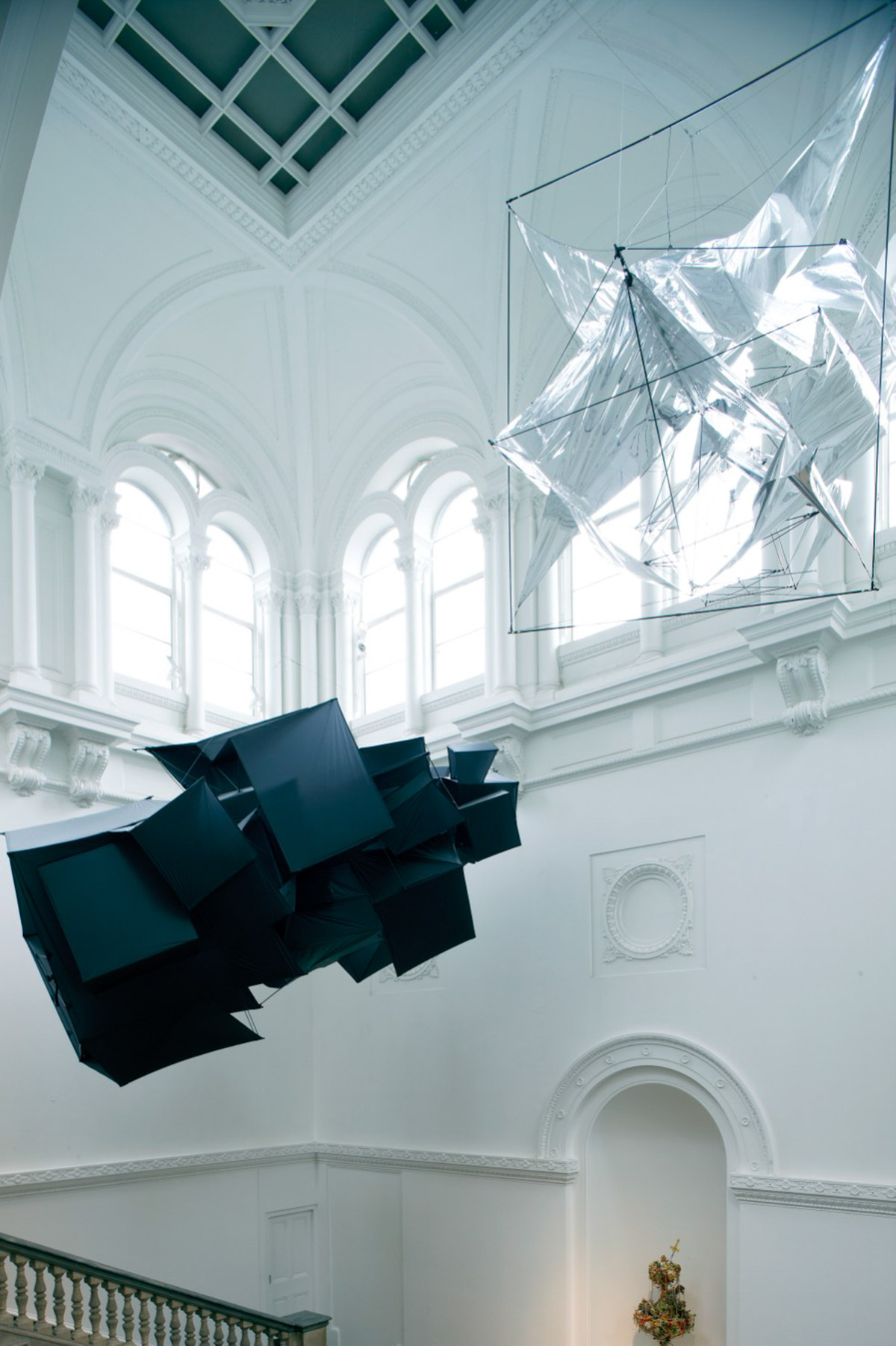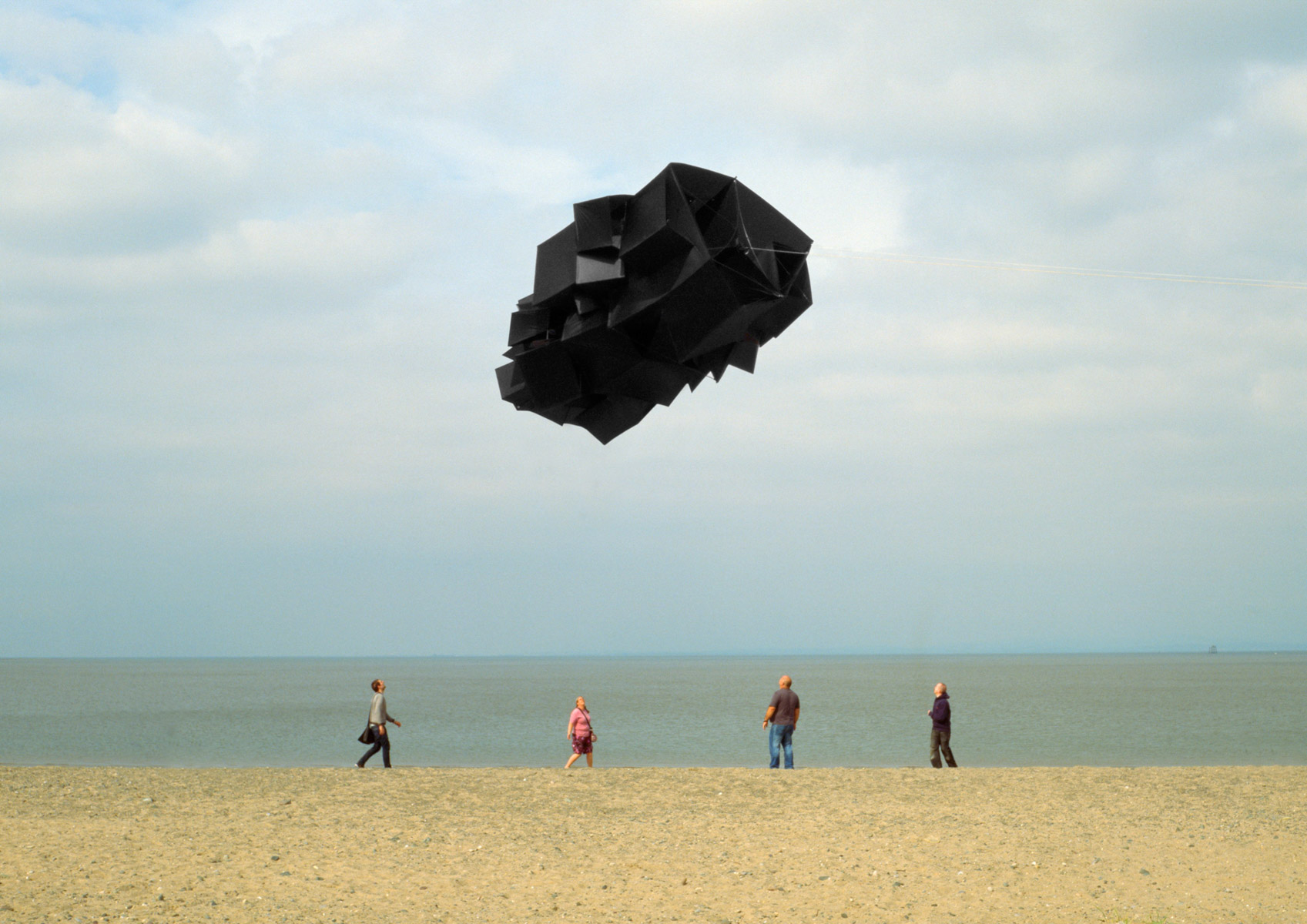2008, Blackpool, UK
Kind, Wise and Loving / The Opposite of All Those Things
Mylar and carbon fibre, 23 x 20 x 33.5 m /
Ripstop fabric and carbon fibre, 26.3 x 33 x 44 m
Commissioned by Grundy Art Gallery, Blackpool, and recommissioned for Mythologies, Haunch of Venison, London, 2009




The Morisons’ visit to Quartzsite in Arizona in 2006 was the starting point for the creation of two flying sculptures: Kind, Wise and Loving, a silver structure made from mylar and carbon fibre, and The Opposite of All Those Things, a similar work created from black ripstop fabric and carbon fibre. During their trip to the American desert town, they had found a number of geometrically shaped crystalline rocks that, although they had been formed by natural processes, appeared to have been fashioned by hand or machine. These objects led the artists to imagine a scaled-up version that was lighter than air and could fly over the city like a floating meteor.
The artists worked with designer Carl Robertshaw of Kite Related Design and architect Sash Scott to realize the project. Both Robertshaw and Scott are former sport-kite world champions, and their passion for kites and for science, art, and nature feed directly into their respective work. Robertshaw explained the appeal of the artists’ proposal: ‘I’m fascinated by opposites and contradictions – an object that appeared to have great mass yet floats in the air. It was a puzzle and a challenge – a good place to start. This was also an opportunity for the studio to explore a theme that we had been talking about for a couple of years: how to make a kite that was not pretty and would challenge the normal perception of kites. Too many kites are “cute”, garish, or cartoon-like – this meteor would oppose those preconceptions. The facets in mineral stones are like the facets of the F117 Nighthawk stealth aircraft. The kite would have surfaces like this that confuse and disguise the symmetry of the structure.’ Not surprisingly, the team selected lightweight materials to produce the sculptures. Mylar is a stretched polyester sheet used to make foil balloons and emergency blankets; ripstop is a woven nylon fabric from which hot air balloons and parachutes are made.
The artists worked with designer Carl Robertshaw of Kite Related Design and architect Sash Scott to realize the project. Both Robertshaw and Scott are former sport-kite world champions, and their passion for kites and for science, art, and nature feed directly into their respective work. Robertshaw explained the appeal of the artists’ proposal: ‘I’m fascinated by opposites and contradictions – an object that appeared to have great mass yet floats in the air. It was a puzzle and a challenge – a good place to start. This was also an opportunity for the studio to explore a theme that we had been talking about for a couple of years: how to make a kite that was not pretty and would challenge the normal perception of kites. Too many kites are “cute”, garish, or cartoon-like – this meteor would oppose those preconceptions. The facets in mineral stones are like the facets of the F117 Nighthawk stealth aircraft. The kite would have surfaces like this that confuse and disguise the symmetry of the structure.’ Not surprisingly, the team selected lightweight materials to produce the sculptures. Mylar is a stretched polyester sheet used to make foil balloons and emergency blankets; ripstop is a woven nylon fabric from which hot air balloons and parachutes are made.
The finished artworks made their debut in Blackpool in October 2008 as part of the artists’ installation at the Grundy Art Gallery, during which The Opposite of All Those Things was flown on the beach (opposite). They also appeared the following year in the Haunch of Venison exhibition Mythologies, held at the former Museum of Mankind in London (now part of the Royal Academy of Arts). In 2011, the artists once again flew The Opposite of All Those Things on Fleetwood beach in Lancashire for a short film produced by Tate Media and Arts Council England.
‘The crystals hung in the air above the grand stone staircase like visitors from another planet. Meteorites. Spaceships. Beautiful abstract forms. They were installed in 6 Burlington Gardens, the old home of the Museum of Mankind, as part
of a show entitled Mythologies. The Morisons had travelled to the Arizona desert in search of minerals of uncanny natural geometry, finding rocks that looked like they have been machined to perfection. The geometric works retained the forms of these rocks, yet instead of being small and
dense they became large, lightweight structures designed to fly. And in flight they became ominous, like meteorites
held in the sky moments before impact. In the gallery, there was a weird contrast between the old and the new, the quasi-Palladian grandeur of the 1860 building and the futurism of the sculptures. Great weight and diaphanous lightness. As the Museum of Mankind had boasted a collection of Japanese kites, it seemed right that these works should be hanging there, swaying gently in the air currents.’
Ben Tufnell, curator, writer, and director of Parafin
‘The crystals hung in the air above the grand stone staircase like visitors from another planet. Meteorites. Spaceships. Beautiful abstract forms. They were installed in 6 Burlington Gardens, the old home of the Museum of Mankind, as part
of a show entitled Mythologies. The Morisons had travelled to the Arizona desert in search of minerals of uncanny natural geometry, finding rocks that looked like they have been machined to perfection. The geometric works retained the forms of these rocks, yet instead of being small and
dense they became large, lightweight structures designed to fly. And in flight they became ominous, like meteorites
held in the sky moments before impact. In the gallery, there was a weird contrast between the old and the new, the quasi-Palladian grandeur of the 1860 building and the futurism of the sculptures. Great weight and diaphanous lightness. As the Museum of Mankind had boasted a collection of Japanese kites, it seemed right that these works should be hanging there, swaying gently in the air currents.’
Ben Tufnell, curator, writer, and director of Parafin
Photographers’ credits
Haunch of Venison_ Peter Mallet / Beach image_Ivan Morison
Haunch of Venison_ Peter Mallet / Beach image_Ivan Morison